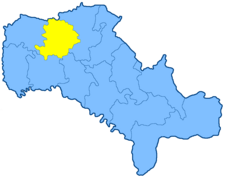| Letichev uezd Летичевскій уѣздъ | |
|---|---|
| Uezd | |
 Coat of arms Coat of arms | |
 Location in the Podolia Governorate Location in the Podolia Governorate | |
| Country | Russian Empire |
| Krai | Southwestern |
| Governorate | Podolia |
| Established | 1795 |
| Abolished | 1923 |
| Capital | Letichev |
| Area | |
| • Total | 2,699.14 km (1,042.14 sq mi) |
| Population | |
| • Total | 184,477 |
| • Density | 68/km (180/sq mi) |
| • Urban | 3.93% |
| • Rural | 96.07% |
The Letichev uezd was a county (uezd) of the Podolian Governorate of the Russian Empire. The uezd bordered the Starokonstantinov uezd of the Volhynian Governorate, the Litin uezd to the east, the Mogilev uezd to the southeast, the Ushitsa uezd to the south, and the Proskurov uezd to the west. The area of the uezd encompassed most of Khmelnytskyi Raion of Ukraine. The administrative centre of the county was Letichev (contemporary Letychiv).
Administrative divisions
The subcounties (volosts) of the Letichev uezd in 1912 were as follows:
| Name | Name in Russian | Capital |
|---|---|---|
| Bakhmatov volost | Бахматовецкая волость | Bakhmatov |
| Voitovtsy volost | Войтовецкая волость | Voitovtsy |
| Derazhnya volost | Деражнянская волость | Derazhnya |
| Zhenishkov volost | Женишковецкая волость | Zhenishkov |
| Zinkov volost | Зиньковская волость | Zinkov |
| Medzhibozh volost | Меджибожская волость | Stavnitsa |
| Mikhalpol volost | Михалпольская волость | Mikhalpol |
| Suslovtsy volost | Сусловецкая волость | Suslovtsy |
Demographics
At the time of the Russian Empire Census on 28 January [O.S. 15 January] 1897, the Letichev uezd had a population of 184,477, including 92,618 men and 91,859 women. The majority of the population indicated Little Russian to be their mother tongue, with a significant Jewish speaking minority.
| Language | Native speakers | Percentage |
|---|---|---|
| Little Russian | 149,120 | 80.83 |
| Jewish | 24,387 | 13.22 |
| Great Russian | 6,809 | 3.69 |
| Polish | 3,164 | 1.72 |
| Bashkir | 405 | 0.22 |
| Romanian | 136 | 0.07 |
| German | 133 | 0.07 |
| Tatar | 121 | 0.07 |
| Czech | 51 | 0.03 |
| White Russian | 27 | 0.01 |
| French | 16 | 0.01 |
| Chuvash | 13 | 0.01 |
| Cheremis | 7 | 0.00 |
| Mordovian | 5 | 0.00 |
| Votyak | 3 | 0.00 |
| Gipsy | 2 | 0.00 |
| Latvian | 2 | 0.00 |
| Other | 76 | 0.04 |
| Total | 184,477 | 100.00 |
Notes
- ^ Prior to 1918, the Imperial Russian government classified Russians as the Great Russians, Ukrainians as the Little Russians, and Belarusians as the White Russians. After the creation of the Ukrainian People's Republic in 1918, the Little Russians identified themselves as "Ukrainian". Also, the Belarusian Democratic Republic which the White Russians identified themselves as "Belarusian".
References
- Волостныя, станичныя, сельския, гминныя правления и управления, а также полицейские станы всей России с обозначением места их нахождения [Volostny, stanichnaya, rural, communes of government and administration, as well as police camps throughout Russia with the designation of their location]. Kiev: Izd-vo T-va L. M. Fish. 1913. p. 162. Archived from the original on 2022-12-11.
- Hamm, Michael F. (2014). Kiev: A Portrait, 1800–1917. Princeton University Press. p. 83. ISBN 978-1-4008-5151-5.
- Fortson IV, Benjamin W. (2011). Indo-European Language and Culture: An Introduction. John Wiley & Sons. p. 429. ISBN 978-1-4443-5968-8.
- ^ "Демоскоп Weekly - Приложение. Справочник статистических показателей". www.demoscope.ru. Retrieved 2019-12-19.